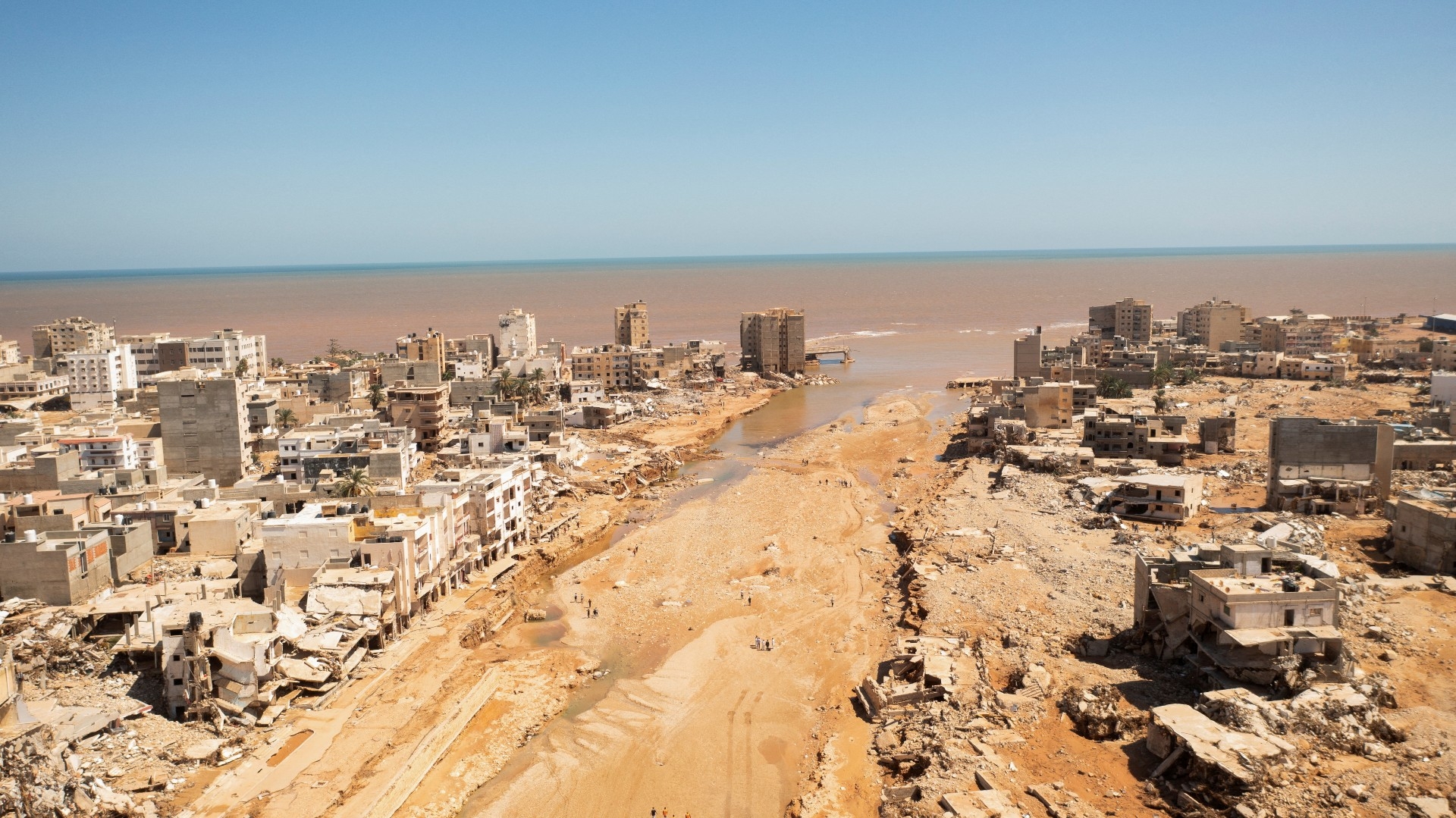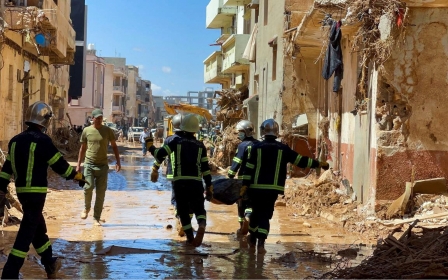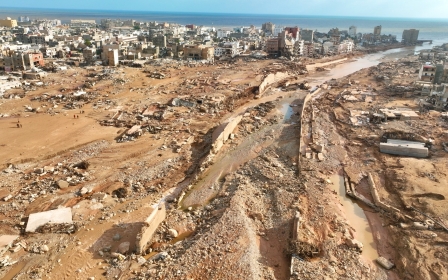Libya floods: How missed warnings and bad calls left Derna to drown

Four days after Storm Daniel tore through the eastern Libyan city of Derna, washing away entire families and their homes, Libyans are struggling to comprehend how such a disaster could have happened. Officials warn that 20,000 may have been killed.
Yet in the hours before the dam on Derna’s outskirts broke, causing catastrophic flooding, authorities and residents alike appear to have been aware of an imminent risk to life.
Sources on the ground and public statements by Libyan authorities reveal a confused and lacklustre response to the dangers, both in the hours before the disaster and on the fateful night that rains pummelled eastern Libya.
On Thursday, the head of the World Meteorological Organisation said “most of the human casualties” could have been avoided if proper warnings had been issued by authorities and evacuations had been carried out.
Storm Daniel had already wreaked havoc in Turkey, Greece and Bulgaria when it reached Libyan shores on Sunday. International observatories warned Libyan authorities, which are split between two competing governments in the east and west, of the danger the storm posed.
New MEE newsletter: Jerusalem Dispatch
Sign up to get the latest insights and analysis on Israel-Palestine, alongside Turkey Unpacked and other MEE newsletters
Officials in the eastern Libya region of Cyrenaica responded by announcing a curfew on Saturday in several cities, focusing particularly on Benghazi, the largest city in the area, which was expected to be the most severely affected.
Osama Hamad, prime minister of the eastern government, asked his minister for local governance, Sami al-Dawi, to form a crisis team “to prepare and take precautionary measures to deal with any emergency consequences”.
In the end, Benghazi was largely spared considerable damage, though the main roads between coastal cities were badly hit. Instead, the rain pooled in the hilly Jabal al-Akhdar, or Green Mountain region, which took 17 hours of heavy rainfall until finally the rain subsided around midnight on Sunday.
Reactive not proactive
That night, calls for help began pouring in from towns and villages in and around the Green Mountain, such as Shahat and Susa, where waters were rising rapidly and trapping residents in their homes.
Although it is known that low-lying areas beneath the Green Mountain are most susceptible to flood damage during annual rains, local authorities and emergency services failed to evacuate people from those regions.
Instead, sources in the area told MEE, authorities decided to be reactive, and eventually declared affected towns and cities a disaster zone. By then, it was too late.
Matters were made worse by Libya being divided by two competing governments: a UN-recognised administration in Tripoli and one in the east backed by a majority of MPs and eastern commander Khalifa Haftar.
The Tripoli-based Government of National Unity (GNU) had released a statement acknowledging the expected torrents in the Green Mountain and assuring emergency teams were ready to respond, but it has no authority or presence in Libya’s east.
Late on Sunday night, GNU Prime Minister Abdulhamid al-Dbeibah said he had told all relevant offices to provide support when needed, and even reassured that his government would take responsibility for compensating people for the damage expected to be caused.
Derna’s mayor, Abdel Moneim al-Ghaithi, declared a curfew in his city at 7pm, describing it as preparations for the storm that was already sweeping through the areas of the Green Mountain, including the city of al-Bayda, 100km away.
The municipality even released images of Ghaithi directing operations and backing the curfew on Sunday night, as waters were rapidly rising and videos were circulating online showing citizens trapped in their homes.
Meanwhile, experts, some of whom last year found the dams in the valley of Wadi Derna were vulnerable to collapse, issued warnings and said residents in the area should be alerted to the danger.
However, local authorities and the divided governments continued to assert that the situation was under control, with authorities in Derna denying reports of the dam's imminent collapse despite numerous news articles speculating about it.
Rising waters
From 11pm on Sunday, Derna’s emergency rooms received non-stop calls from distressed residents, particularly those in the countryside upstream, where homes began to be submerged.
In Derna, Libyans living in the buildings running alongside the valley saw an unprecedented amount of water gushing down the canal running between the dam and the sea. Local authorities continued to urge people to stay home.
The waters in the canal grew with increasing ferocity, breaking out of the banks and reaching surrounding roads and buildings. At around 1.30am, response teams were dispatched to several neighbourhoods, with reports coming in that people were trapped and drowning.
'We were on the roof of our four-storey house, attempting to escape the flood. But all that remains of my family is me'
– Flood survivor
A resident of al-Bayda, who wished to remain anonymous, told MEE that he was dealing with severe flooding in his own home when he began to receive video clips from Derna showing torrents raging down the canal.
“I immediately contacted my relatives living near the canal and urgently instructed them to evacuate to a safer location and alert others about the gravity of the situation,” he said.
They followed his instructions and moved from al-Wadi Street, which runs alongside the canal, to a safer part of the city.
Survivors from Derna currently sheltering in al-Bayda told MEE that they heard the sound of an explosion at 2.30am. The dam had broken.
They said a flash flood ripped through several areas of the city, including the historic old city. Residents of al-Wadi Street were swept into the sea. High-rise residential buildings of eight floors were washed away. Water flowed into Derna at an estimated 3,500 cubic metres per hour.
That coincided with a total power and communications blackout. Authorities began to come forward, acknowledging the scale of the disaster and calling for immediate intervention.
One survivor, identifying himself only as A, described to MEE the moment the waters enveloped him.
“We were on the roof of our four-storey house, attempting to escape the flood. But all that remains of my family is me,” he said.
“The rest of them went missing after the water swept us away, leaving me alone on one of the city streets. I am still searching for the bodies of my family, but with no success.”
Today, Derna is searching for its dead and burying them when it can. The city quickly ran out of bodybags.
Bodies are being transported in trucks from the city centre to areas like Dahr al-Hamar south of the city, and Martouba, where thousands of city residents have been interred. The rescue, recovery, assessment and aid teams struggle with limited resources.
Many of the dead lie in the street, waiting to be identified. The seas wash up more every day.
Divers are ready to search the waters, but they remain too rough for now.
Freediving instructor Deya Abu Zariba told MEE: “The main challenge for divers is the change in seawater colour to reddish clay, severely obstructing visibility. The sea conditions are extremely treacherous, featuring strong undercurrents, upwelling and waves reaching up to two metres in height.”
He added: “The seabed in that area is strewn with sharp rocks and construction debris, posing significant risks to divers and potentially leading to further loss of life, instead of the recovery of victims’ bodies."
This article is available in French on Middle East Eye French edition.
Middle East Eye delivers independent and unrivalled coverage and analysis of the Middle East, North Africa and beyond. To learn more about republishing this content and the associated fees, please fill out this form. More about MEE can be found here.






